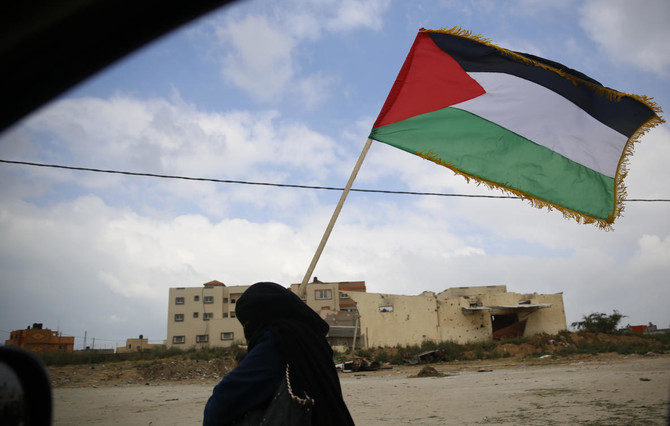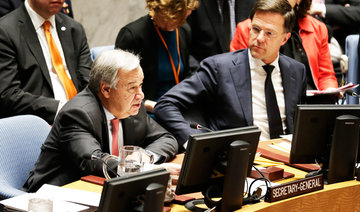GAZA CITY, Palestinian Territories: Palestinians prepared for further protests near the Gaza border Saturday, a day after a major demonstration led to clashes that saw Israeli forces kill 16 people in the bloodiest day since a 2014 war.
Protesters began returning to a tent city erected near the border with Israel to resume the demonstration planned to last six weeks in the blockaded enclave.
Thousands were attending funerals for those killed, with mourners holding Palestinian flags and some chanting “revenge.”
A general strike was being held in both the Gaza Strip and the occupied West Bank.
Israel defended its soldiers’ actions on Friday, when troops opened fire on Palestinians who strayed from the main tent city protest — attended by tens of thousands — and approached the heavily fortified fence cutting off the Gaza Strip.
The Israeli military says it opened fire only when necessary against those throwing stones and firebombs or rolling tires at soldiers.
It also said there were attempts to damage the fence and infiltrate Israel, while alleging there was an attempted shooting attack against soldiers along the border that caused no casualties.
But Palestinians accused Israel of using disproportionate force, while human rights groups questioned Israel’s use of live fire.
UN chief Antonio Guterres called for an “independent and transparent investigation.”
In addition to the 16 killed, more than 1,400 were wounded, 758 of them by live fire, with the remainder hurt by rubber bullets and tear gas inhalation, according to the Gazan health ministry.
No casualties were reported among Israelis.
Palestinian president Mahmud Abbas declared Saturday a day of national mourning and in a speech said he held Israel fully responsible for the deaths.
“The large number of martyrs and people wounded in peaceful popular demonstrations shows that the international community must intervene to provide protection to our Palestinian people,” he said.
An Israeli military spokesman said Friday’s events were “not a protest demonstration” but “organized terrorist activity.”
He accused Hamas, the Islamist movement that runs the Gaza Strip and which has fought three wars with Israel since 2008, of being behind it and threatened wider military action if it continued.
“If it continues, we shall have no choice but to respond inside the Gaza Strip against terrorist targets which we understand to be behind these events,” Brig. Gen. Ronen Manelis told journalists.
The six-week protest is in support of Palestinian refugees and the timetable holds significance for a range of reasons that have added to tensions.
It began on Land Day, when Palestinians commemorate the killing of six unarmed Arab protesters in Israel in 1976, and as Jewish Israelis readied to observe the Passover holiday, which started at sundown on Friday.
Protests will continue until the United States opens its new Jerusalem embassy around May 14, a move that has provoked deep anger among the Palestinians, who see the city’s annexed eastern sector as the capital of their future state.
May 14 will also mark 70 years since the creation of Israel, while Palestinians will commemorate what they call the Nakba, or “catastrophe,” the following day.
Nakba commemorates the more than 700,000 Palestinians who either fled or were expelled from their homes in the war surrounding Israel’s creation in 1948.
US President Donald Trump has harshly criticized the Palestinians in the past, but the State Department said only that it was “deeply saddened” by the loss of life and urged steps to lower tensions.
Human Rights Watch criticized Israel’s actions.
“Israeli allegations of violence by some protesters do not change the fact that using lethal force is banned by international law except to meet an imminent threat to life,” the New York-based group said, calling the number of killed and wounded “shocking.”
Israel’s arch-foe Iran, a longstanding supporters of Hamas, condemned the “shameful” killing of protesters and mocked the fact that it happened as Israeli Jews prepared to mark Passover.
“On the eve of Passover (of all days), which commemorates God liberating Prophet Moses and his people from tyranny, Zionist tyrants murder peaceful Palestinian protesters — whose land they have stolen — as they march to escape their cruel and inhuman apartheid bondage,” Foreign Minister Mohammad Javad Zarif tweeted.
Israel had deployed troop reinforcements along the border, including more than 100 special forces snipers, saying it would prevent attempts to break through the fence.
Protests along the border are common, often culminating in young Palestinian men throwing stones at Israeli soldiers who respond with tear gas along with rubber and live bullets.
But the “March of Return” protest that began on Friday is larger scale and is intended to involve families with women and children camping in tent cities near the border for weeks.
Gazans ready for new protests after bloodiest day in years
Gazans ready for new protests after bloodiest day in years

US military launches strikes in Syria against Daesh fighters after American deaths

- “This is not the beginning of a war — it is a declaration of vengeance,” Defense Secretary Pete Hegseth says
- President Trump earlier pledged “very serious retaliation” but stressed that Syria was fighting alongside US troops
WASHINGTON: The Trump administration launched military strikes Friday in Syria to “eliminate” Daesh group fighters and weapons sites in retaliation for an ambush attack that killed two US troops and an American interpreter almost a week ago.
A US official described it as “a large-scale” strike that hit 70 targets in areas across central Syria that had Daesh (also known as Islamic State or IS) infrastructure and weapons. Another US official, who also spoke on condition of anonymity to discuss sensitive operations, said more strikes should be expected.
The attack was conducted using F-15 Eagle jets, A-10 Thunderbolt ground attack aircraft and AH-64 Apache helicopters, the officials said. F-16 fighter jets from Jordan and HIMARS rocket artillery also were used, one official said.
“This is not the beginning of a war — it is a declaration of vengeance. The United States of America, under President Trump’s leadership, will never hesitate and never relent to defend our people,” Defense Secretary Pete Hegseth said on social media.
President Donald Trump had pledged “very serious retaliation” after the shooting in the Syrian desert, for which he blamed Daesh. The troops were among hundreds of US troops deployed in eastern Syria as part of a coalition fighting the terrorist group.
Trump in a social media post said the strikes were targeting Daesh “strongholds.” He reiterated his support for Syrian President Ahmad Al-Sharaa, who he said was “fully in support” of the US effort to target the militant group.
Trump also offered an all-caps threat, warning the group against attacking US personnel again.
“All terrorists who are evil enough to attack Americans are hereby warned — YOU WILL BE HIT HARDER THAN YOU HAVE EVER BEEN HIT BEFORE IF YOU, IN ANY WAY, ATTACK OR THREATEN THE USA.,” the president added.
The attack was a major test for the warming ties between the United States and Syria since the ouster of autocratic leader Bashar Assad a year ago. Trump has stressed that Syria was fighting alongside US troops and said Al-Sharaa was “extremely angry and disturbed by this attack,” which came as the US military is expanding its cooperation with Syrian security forces.
Syria’s foreign ministry in a statement on X following the launch of US strikes said that last week’s attack “underscores the urgent necessity of strengthening international cooperation to combat terrorism in all its forms” and that Syria is committed “to fighting Daesh and ensuring that it has no safe havens on Syrian territory and will continue to intensify military operations against it wherever it poses a threat.”
Daesh has not claimed responsibility for the attack on the US service members, but the group has claimed responsibility for two attacks on Syrian security forces since, one of which killed four Syrian soldiers in Idlib province. The group in its statements described Al-Sharaa’s government and army as “apostates.” While Al-Sharaa once led a group affiliated with Al-Qaeda, he has had a long-running enmity with Daesh.
Syrian state television reported that the US strikes hit targets in rural areas of Deir ez-Zor and Raqqa provinces and in the Jabal Al-Amour area near Palmyra. It said they targeted “weapons storage sites and headquarters used by Daesh as launching points for its operations in the region.”
Trump this week met privately with the families of the slain Americans at Dover Air Force Base in Delaware before he joined top military officials and other dignitaries on the tarmac for the dignified transfer, a solemn and largely silent ritual honoring US service members killed in action.

The guardsmen killed in Syria last Saturday were Sgt. Edgar Brian Torres-Tovar, 25, of Des Moines, and Sgt. William Nathaniel Howard, 29, of Marshalltown, according to the US Army. Ayad Mansoor Sakat, of Macomb, Michigan, a US civilian working as an interpreter, was also killed.
The shooting nearly a week ago near the historic city of Palmyra also wounded three other US troops as well as members of Syria’s security forces, and the gunman was killed. The assailant had joined Syria’s internal security forces as a base security guard two months ago and recently was reassigned because of suspicions that he might be affiliated with Daesh, Interior Ministry spokesperson Nour Al-Din Al-Baba has said.
The man stormed a meeting between US and Syrian security officials who were having lunch together and opened fire after clashing with Syrian guards.
When asked for further information, the Pentagon referred AP to Hegseth’s social media post.













